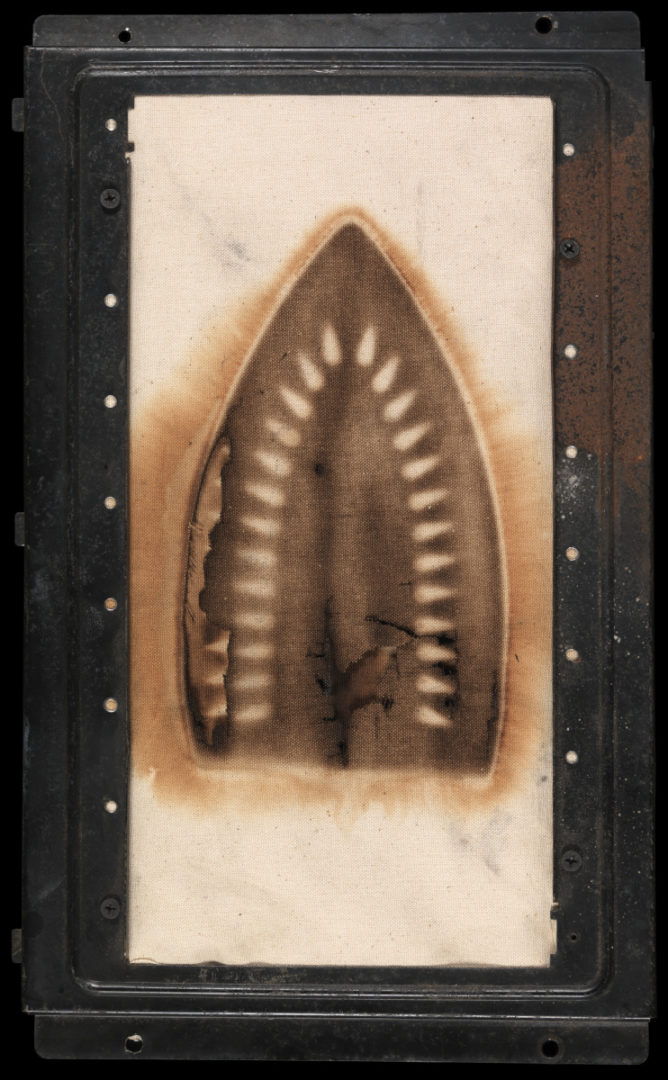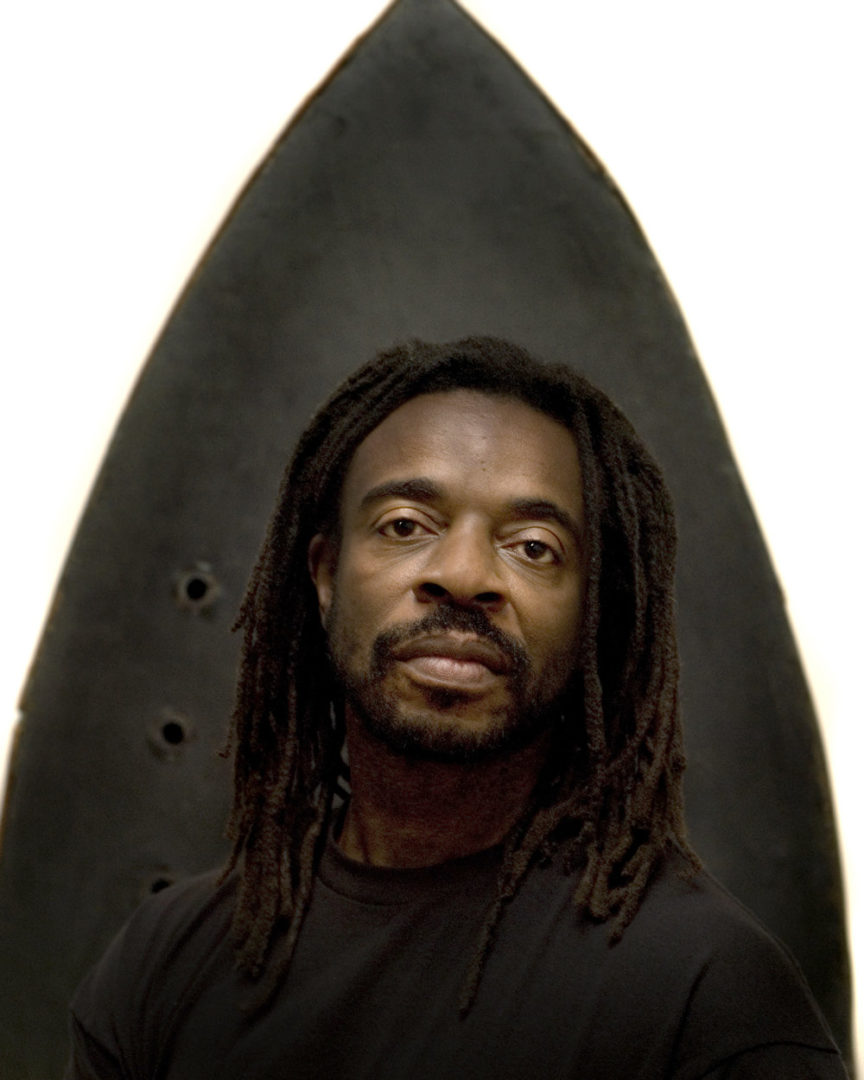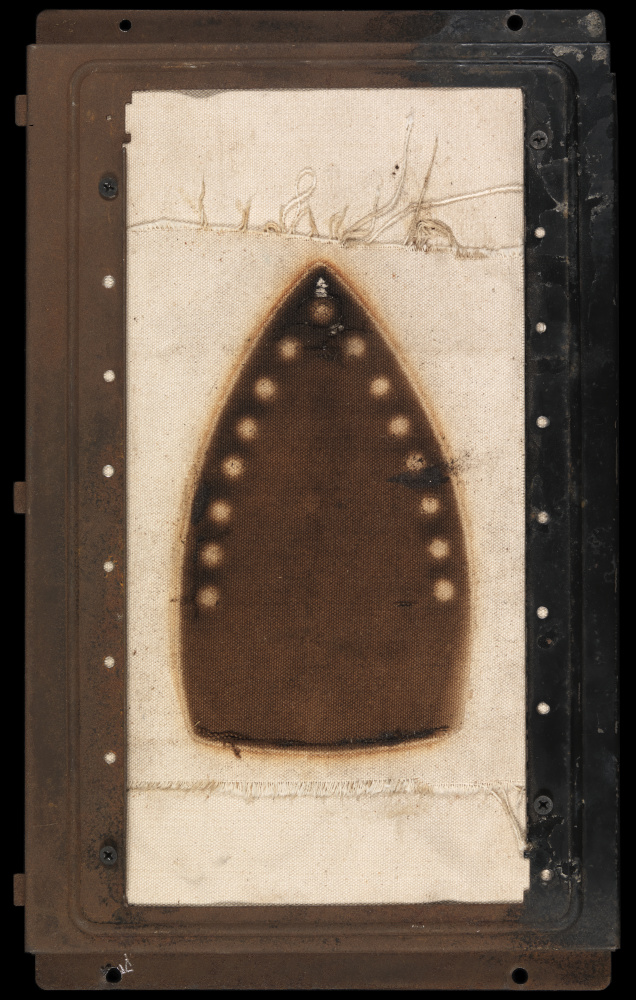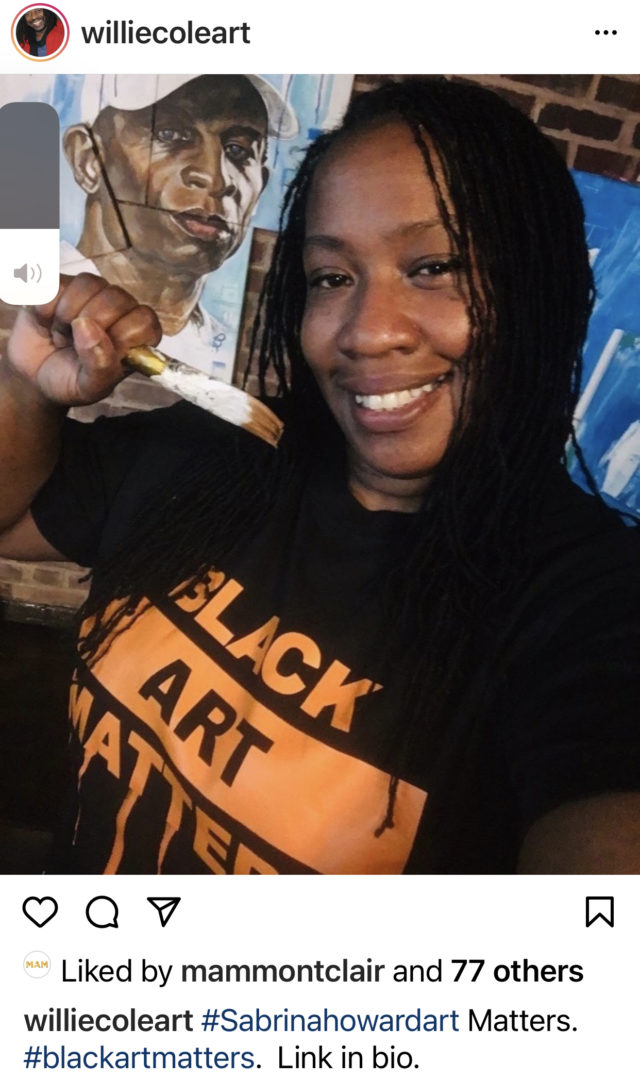- Open today, 10 am to 5 pm.
- Parking & Directions
- Free Admission
Evolution of an Artist: In Conversation with Willie Cole
Irons, water bottles, shoes—you name it—Willie Cole can turn it into a work of contemporary art. His sculptures made of shoes recently caught the eye of avant-garde designer Rei Kawakubo, who collaborated with Cole for Comme des Garcons Homme Plus’ fall/winter 2021 men’s collection. Last month, Cole designed headpieces from clusters of black pumps for Kawakubo’s runway show.

Willie Cole (American, b. 1955), Untitled, 1991, Scorch on canvas in metal frame, Gift of the American Academy of Arts and Letters, New York; Hassam, Speicher, Betts, and Symons Funds, 2011 © Willie Cole, 2011.5.1
His scorched canvases, two of which are in the Chrysler Museum’s permanent collection, were created with an iron and resemble historical diagrams of slave ships. The works also reference the domestic labor of his elders. Some of those same designs are a part of his Black Art Matters collection, a line of apparel, mugs, and accessories available in the Chrysler’s Museum Shop. He designed the merchandise last year to advocate for Black artists and emphasize the importance of the work Black artists create. Ten percent of the proceeds benefit Wells Bring Hope, an organization committed to providing safe, clean water to rural villages in Niger, West Africa.
In a conversation with DeAnne Williams, the Chrysler Museum’s Content Manager, Cole shares more about the motivation behind his work and the evolution of his artistic practice.

Willie Cole
DeAnne Williams: What inspired the Black Lives Matter collection?
Willie Cole: When the pandemic struck, all the museums, galleries, and universities closed down. Those are the three legs of my survival. Before I was ‘Willie the Artist,’ I was a graphic designer. I knew I had to do something in graphic design that would appeal to everybody, so by the time Black Lives Matter became a big issue in this country, the idea hit me; I should do Black Art Matters. It was artist survival, and it was a good point to make in the world because my journey as an artist has gone through so much.
When I got out of college in 1976 and worked as a graphic designer/illustrator in New York, I encountered lots of racism. They would say my paintings looked too ethnic, so they couldn’t use them. I did book covers for a couple of magazines in New York and they never published my stuff because they said it looked too ethnic. In 1978, I was an artist in residence at the University of Delaware. I was outside the New York art scene and Jean-Michel Basquiat was on the rise. A few years later, he died. But up until his death, most of the galleries in the New York scene did not have any artists of color. Basquiat’s death was a big turning point, and I just wanted to emphasize our importance from that point forward. Before he died, we didn’t matter, but he was highly exploited and marketed and they saw a benefit in that, so every gallery in New York got one Black artist. It’s grown since then, but not that much.
In my education, we studied the Renaissance but never studied any artists of color. I was involved in the protest at the Newark Museum of Art back in the 1970s because they had no Black artists in the collection and it was a Black town. So Black Art Matters is about education. It is about celebration, inspiration, and acknowledgment. Every time a Black artist or any artist buys that merchandise and sends me a picture, I post an image on Instagram and I replace the words ‘Black Art’ with their name.
DW: How have your encounters with racism over the years shaped the art you’ve created?
WC: When I was an illustrator in the 1970s, I was doing romance novel covers. The publishers would set up the photo session and give me the photos of the models. The models were always white, and the publishers rejected my work in the end because it looked too ethnic. So, I started doing children’s stories and creating animals instead of people, but I still didn’t get much work. I got work from the Black ad agencies in New York only. UniWorld was the agency big in New York back then. During Black History Month, I got work from a couple of corporations like General Motors. Then I started writing and illustrating my own stories, and I had two books published in the 1970s through Ebony Jr. magazine.
I moved into fine art post-Basquiat. [Galleries] were looking for Black artists, but they did not recognize or ‘discover’ me—for lack of a better word—as a painter. They discovered me as a sculptor. My sculpture was made from other objects so the race, at least the obvious skin tone race thing, wasn’t applicable at that time to describe my work. They connected it to African art, which was fine with me. In the 1990s, a New York Times article said it was the decade of African art, so I became very visible in the New York arts scene during that decade. That was a plus for me.
DW: I can tell already that you have a love for painting. Is that your favorite medium?
WC: It is. I’ve always loved French painters. I love Monet. I love the Romantic French painters like David. I was doing paintings and drawings in the style between the Romantic painters and the Impressionists and got no attention in the art world. During the pandemic, I’ve started doing some of those paintings again and have gotten no response because they want me to do ‘that African thing.’ They don’t come out and say it—well one dealer said it—but they want me to do the sculpture. Fortunately, I enjoy doing it, but I really miss the paintings. I’ve done five giant Impressionist-style paintings—abstract Impressionism almost because they’re non-figurative—and I haven’t gotten any response. But my life is about more than the art world. It’s really just about today because tomorrow’s not guaranteed. So, I just do what I enjoy each day.
I was out of painting for many years because I needed to make a living, so I made sculpture. The pandemic kind of freed me up a bit because nobody was selling or buying anything from me anyway. I’ve also started writing and illustrating a children’s story, which I’m still working on now.
DW: What do your children’s stories focus on?
The ones I did back in the ‘70s focus on health and nutrition because I was on a journey toward being a vegan starting in 1971. By the time I started having children in 1978, I wanted to give them stories to help motivate and encourage them to have what I call a healthier diet. The one I’m working on now is about one of my sculptures. I did a sculpture that looks like it should fly. It’s made out of shoes and named it Shoe Fly, so that became a cartoon character. I’ve been writing stories about that for two years now. I plan to finish one of them within the next couple of weeks, and I’m going to self-publish it.
DW: That’s amazing to be able to do everything yourself.
WC: It is. Last night I watched CNN International, and they interviewed a woman in Nigeria who used to be in the corporate world. At 40, she asked herself what else she wanted in life and she changed her whole life. Now she’s like the Oprah Winfrey of Nigeria. She’s produced movies and she owns giant hotels. I found that very inspiring. I always thought my talent was not making art. My talent is being creative. I write stories. I play music. The pandemic has made me think about those things more, so I’m working in these directions more too. All of that fits under Black art.
DW: We’re in an interesting time in the world right now. How do you think this current time has impacted Black art?
WC: I would hope that it’s made artists be more independent because it has definitely changed the art world. The internet had already started ushering in big change in the art world because now you can get international exposure just from your Facebook page and without having an art gallery or being in an art magazine. I’ve gotten a lot of commissions from Instagram. I make chandeliers out of plastic water bottles. They’re all commission pieces, and they all come through Instagram. People see the page and they go to my website and reach out from there. People are spending more time in their homes and focusing more on their décor. I’ve had three family commissions since the pandemic, and I’m working on one now.
DW: Chandeliers out of water bottles—I love it! How did you come up with that idea?
WC: I always say the ideas don’t come out of people. They come into people. So, I was just open for it and everything came together at the right time. I had the opportunity to do an exhibition at a sculpture park in New Jersey. They have a beautiful facility, but when it came to my show, they had no budget. I thought my work would be outside in the park, but they wanted it in the indoor galleries. During that meeting, I was drinking water and I was squeezing the bottle because it has all these lines in it so it can collapse in the landfill. I realized in that moment that I could make things out of bottles just by squeezing them and flattening them. At night, I dreamed about a chandelier and that’s how it came.
I want to take those to a more decorative and interior design market and not in the fine art world. I have two in Colombia in South America and one in a movie theater in Pennsylvania. I have them in people’s homes and each one is a little different structurally. So, my task now is to make it more of a repeatable thing where I know how I’m going to do it. Right now, it varies based on what I have around the house. I need a more standardized construction process.

Willie Cole (American, b. 1955), Untitled, 1991, Scorch on canvas in metal frame, Gift of the American Academy of Arts and Letters, New York; Hassam, Speicher, Betts, and Symons Funds, 2011, 2011.5.2
DW: We have two of your scorched canvases in the Chrysler collection. I understand that’s a process you turned to repeatedly. What inspired your use of an iron for art?
Similar to the water bottles, I was making clothing-like sculpture out of woven steel. I lived in a factory and my neighbor had been a fabricator. I would get her scraps and make jackets and full-body armor. Then I got a residency at The Studio Museum in Harlem, and I was living in Newark so I would catch the train to New York. From my loft to the train station was a one-mile walk. During that walk, I saw an iron on the street that had been run over by a car and it was totally flat. It looked like an African mask, so I picked it up, brought it into the house, took a lot of photographs of it, and it just began to communicate to me how it could change my life. During that whole journey, I started to make personal connections—one being that my great-grandmother worked as a domestic. She was still alive back in 1990 when I was doing this, and I actually had some of her irons that I was supposed to be repairing at the time. I didn’t know how to repair an iron. I was trying to be a good great-grandson. So, I had a lot of broken irons, but I never connected them to artmaking. But once I had this runover iron on the street, I made those connections and I started finding irons everywhere. My loft at the time used to be a sweatshop, and I had been there for maybe five years before I started making art out of irons. But once I started making art out of irons, I started discovering scorch marks on the floor of this studio and that led me to start doing the scorches.
DW: What inspired you to pursue a career in art?
WC: I believe in reincarnation, and I think I was an artist in a previous life. At three years old, my mom discovered me in the kitchen drawing cartoons from the comic strips in the newspaper, so from that point on, my family started calling me the little artist. That just kind of got me all programmed and I started going to art camps in the summer and taking art classes, but I didn’t know what art form I’d be involved in. By the time I was eight years old, I was branching off into music.
By the time I got to high school, I was branching off into creative writing and theater. I knew I would be in the arts. I didn’t know what my art form would be. My major in high school was music and fashion illustration. I got accepted into the Fashion Institute of Technology but those were the years of homophobia, so I was discouraged from going there. I went to the School of Visual Arts in New York City instead. While I was at Visual Arts, I was involved in the Negro Ensemble Theater Company in Manhattan and the National Black Theater of Harlem. When I left New York and went to Boston University as an art major, I was the main writer and director in the Black Theater Alliance. Once I got out of school, I started writing and illustrating stories and trying to sell them, but I didn’t have a whole lot of success.
When I finally got a real job in 1978, it was in theater. I was an artist in residence in the theater department at the University of Delaware. They didn’t know I was a visual artist. It was a children’s theater company. When they discovered I was a visual artist, they started asking me to design posters for their productions and my role in the theater productions became smaller and smaller, which gave me a lot of time just to be in my apartment drawing and painting, which was great.
When I went back to New Jersey in 1979, I started to pursue a career as a fine artist but we didn’t know how to do it back then. I’d send a page of 35mm slides to galleries all over the world, and I always got them all back. I ended up getting a job as a computer graphics artist in 1980 and did a lot of freelance stuff for all of the nonprofits. I worked for New Jersey Ballet, New Jersey Opera, and New Jersey Orchestra.
I used to go to New York once a month and hit all of the galleries. In 1983, one of the galleries responded to me and that was my first deal in New York. I got fired from my computer job in 1982, so I spent a year just painting. When I had my first deal in 1983 in New York, I never looked back. Even though I had a deal, I was still in bands and still writing plays, but I wasn’t making a lot of money. So, after a couple of years, I figured I should just focus on the fine arts for a while, and I did that exclusively until a few years ago. Now I’m trying to bring that back up to speed. I’m ready for much more. Even though I’m a senior citizen, I’m being born again. I’m in my twenty-sixth year of being forty, so I still got a lot of juice.
Willie Cole’s art is in the permanent collection of several museums including the Chrysler Museum of Art, The Metropolitan Museum of Art, the High Museum of Art, the National Gallery of Art, The Museum of Modern Art, and The Newark Museum of Art.


